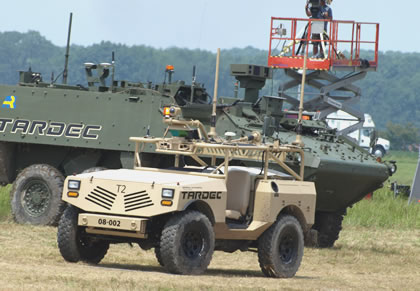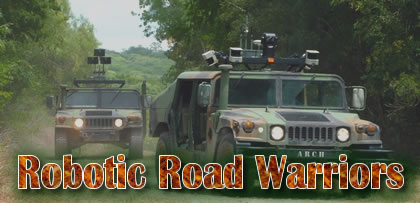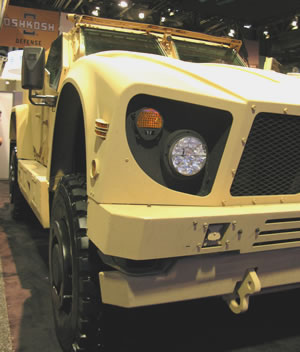
AUSA, Washington DC, October 2009: The Army’s newest acquisition – M-ATV , was displayed in a shining new example at prime contractor’s Oshkosh booth at AUSA 2009 before it is shipped to the dusty war torn battlegrounds of Afghanistan. Nearby, Oshkosh displayed a Technology Demonstrator (TD) hinting about what the future applications of tactical vehicles could be – this M-ATV like vehicle was featuring autonomy, exportable power on demand and all-terrain mobility. The TD is equipped with the TerraMax system, integrating sensors, artificial intelligence and drive-by-wire technology to function in autonomous, leader-follower or manually driven modes.

Unlike the big and yellow TerraMax truck robot that participated in the DARPA Challenge, the TD is better configured for military operations, and actually looks like an ordinary M-ATV. Its sensors are concealed, and control systems are installed as an integral kit, converting the standard vehicle into an autonomous one. Such vehicles could be operating in manned-unmanned convoys, reducing the vulnerability, manpower and protection assets needed to supporting logistical operations in the combat zone. Another system being tested by Oshkosh in the TD vehicle is the Command Zone – a multiplexed electronics system that controls and diagnoses all major vehicle systems, allowing its major components to work together efficiently. The vehicle is fitted with the ProPulse hybrid-electric propulsion system, capable of supporting forward deployed units with electrical power. In this configuration, the hybrid propulsion system can provide 60 kVA of electrical power.

Another advanced technology truck demonstrated by Oshkosh is the Heavy Expanded Mobility Tactical Truck (HEMTT) A3 series featuring ProPulse diesel-electric drive technology which improves fuel efficiency by at least 20 percent over current HEMTT models. The vehicle uses an on-board electrical generator delivering up to 120 kW of military-grade AC power. The By eliminating the driveshaft and differentials, the Propulse system employs electrical motors to drive the wheels, clearing enough space for Enhanced Load Handling System (ELHS) that can be flown in and unload from a C-130. Oshkosh has already produced three prototypes of the vehicle, used for durability testing. One of the proposed configurations of this platform is the Mobile Centurion – a mobile version of the counter-rocket and mortar gun, protecting high-value site defense. The C-130 transportable HEMMT A2 provides cross-country mobility for logistics support carrying loads up to 13-tons. HEMMT A4 is currently in production, featuring long-term armor strategy (LTAS) A-kit cab which can be upgraded to LTAS B-kit when required.
Lockheed Martin is also developing technology to support a mixed manned-unmanned convoy, through the Convoy Active Safety Technology (CAST) – a kit-based platform that can turn a conventional truck into an autonomous member of convoy with a push of a button. Utilizing the company’s developed AutoMate sensor and actuator kit, CAST enables the trucks operating in a convoy to maintain lateral and longitudinal position along the road and relative to the leading vehicle. Autonomously avoiding obstacles, and maintaining constant interval between vehicles, these robot trucks will improve convoy safety, security, survivability and sustainment, reducing crew fatigue, eliminate rear-end collisions. The system has already been integrated in FMTV and M915 vehicles, performing convoy operation of five vehicles. CATS is designed to support movement at speeds of 50 mph on paved roads and 35 mph on dirt roads, operate in day and night, under limited visibility conditions, and handle split autonomous and rejoin maneuvers, when required.
These vehicles were recently demonstrated their autonomous convoy mission capability at a three day Robotics Rodeo event organized by the U.S. Army III Corps at Ft. Hood, sponsored by the U.S. Army Tank Automotive Research, Development and Engineering Center (TARDEC). Some 30 companies participated in the demonstrations, which included remotely controlled, autonomous, leader-follower performance. Among the companies demonstrating such systems were Autonomous Solutions, teamed with Boeing on the development of a remotely controlled vehicle technology; Kairos Autonomi demonstrating the Pronto 4 Strap-on Autonomy System, converting an ordinary car into a tele-operated or semi-autonomous vehicle. TORC Technologies demonstrated how a convoy tele-operated lead vehicle can perform dynamically in a convoy protection missions, absorbing attacks of roadside bombs without risking human lives. SImilar man-unmanned teaming was also demonstrated by General Dynamics Robotics Systems.
For more coverage see Mark Rutherford‘s feature on CNET Military Tech News.




















